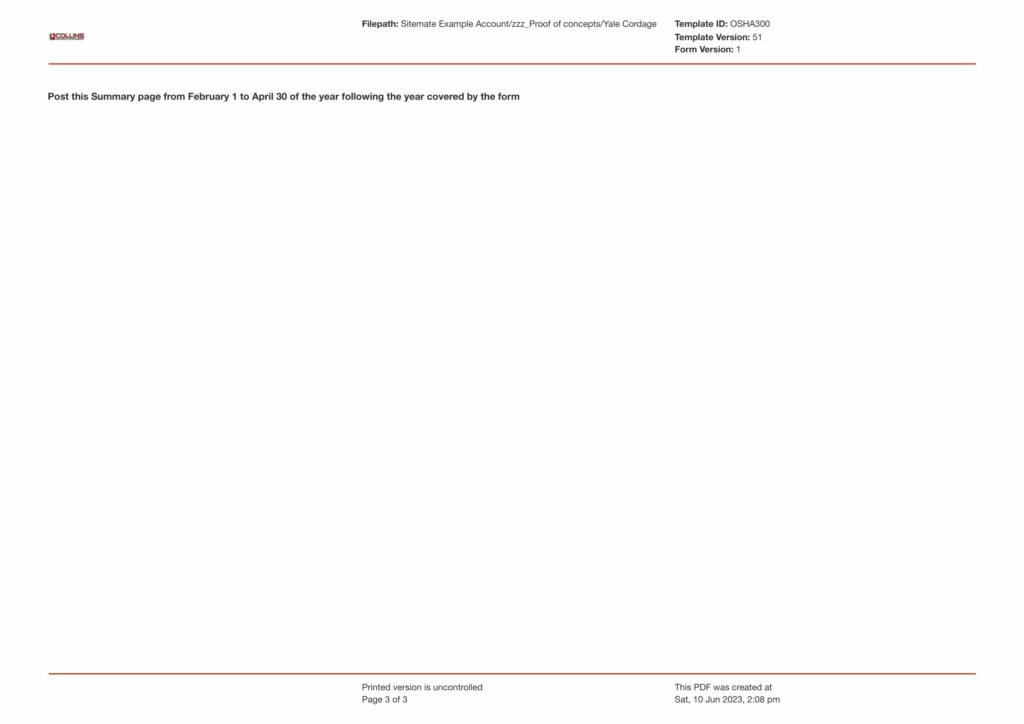Dashpivot article page – OSHA 300 calculator
OSHA 300 Incident Rate Calculator
In this article, learn about the OSHA 300 Incident Rate, how to calculate it to get started, show useful ways to monitor incident rates, and provide an effective resource to better manage OSHA 300 incident rates in the workplace.

OSHA reported 2.4 incidents per 100 full-time employees (FTEs) in 2023. That’s the lowest since 2003 but we can’t get complacent. Behind every workplace incident is a real person – someone’s parent, spouse, friend or child. Statistics help us track progress but they don’t tell the whole story of how workplace accidents impact lives, families and communities. Using the correct OSHA 300 incident rate calculator and calculation method ensures you are doing your part to keep people safe.
That’s where industries should be interested first – documenting everything possible for the overall well-being of employees.
Think about it: when was the last time you noticed a potential safety hazard at work? Maybe it was a wet floor without a sign, a ladder leaning against the wall or damaged electrical equipment. These everyday observations matter because they prevent accidents from happening.
One of the tools we use to measure workplace safety is the incident rate – it’s like a safety report card that shows how well we’re protecting our workers. Whether you’re a safety manager, supervisor or business owner, knowing your OSHA 300 Incident Rate isn’t just about compliance; it’s about having a workplace where everyone goes home to their loved ones at the end of every shift.
What is the OSHA 300 Incident Rate?
OSHA 300 Incident Rate is also known as Total Recordable Incident Rate (TRIR) or Total Case Incident Rate (TCIR). It’s a calculation that measures the frequency of recordable injuries or illnesses in a given period, usually a year.
This is used by companies, OSHA and others to compare and benchmark different companies, industries or time periods.
This is not part of your OSHA 300 requirements but is considered good for safety and worker morale.
How do you calculate your OSHA Incident Rate?
List all workplace injuries and illnesses for a given period that meet OSHA’s recordable definition during the reporting period – usually a year. That will include medical cases over first aid; work-related fatalities; cases where persons were days away from work; cases with restrictions from work; and occupational illnesses with adequate documentation on the OSHA 300.
Next add up all the hours for the same period for all employees – regular time, overtime hours, part-time and temporary workers. Exclude holidays and holiday periods or sick days.
The formula is:

The 200,000 is the standard benchmark, 100 employees working 40 hours a week for 50 weeks.
Take this as an example:
If a company had 5 recordable injuries in a year and the total hours worked by all employees for the year was 500,000:
OSHA Incident Rate = (5 x 200,000/500,000) = 2
That means 2 recordable injuries per 100 employees for that year.
How to Use Results: What does your OSHA 300 Incident Rate Calculation mean?
Companies must know how to use the Incident Rate results to determine if a workplace is safe to work or not.
Lower OSHA Calculated Incident Rates
A lower OSHA Incident Rate means fewer recordable incidents compared to total hours worked means a safer workplace or better safety measures.
Higher OSHA Calculated Incident Rates
A higher OSHA Incident Rate means there are specific safety issues to be looked into related to workplace practices.
Incident Rates Across Multiple Industries
The incident rates of different industries will be different. That wouldn’t make sense comparing the OSHA incident rate of a construction company to that of an office vs two companies in the same industry.
Standardising the incident rate calculation will allow for an apples-to-apples comparison between companies and industries of all sizes that will show areas to improve for OSHA.
Why monitor your OSHA incident rate?
There are many reasons to require monitoring of OSHA incident rate from a business and health and safety perspective. Here are some:
Employee Safety and Well-being
An organisation can monitor and analyse the OSHA Incident Rate and it will show a safety issue in the area. In this case, you can prevent further injuries and illnesses and have a safer work life for employees.
OSHA Compliance
Monitoring of incident rates ensures a company is in compliance with OSHA’s record-keeping and reporting requirements. Non-compliance means fines and penalties which can be avoided when there is a systematic record-keeping in place.
Industry Benchmarking and Comparison
Having a standard OSHA Incident Rate, companies can compare with the industry average or other years. That means a company can compare to other similar companies or how they performed against previous years.
Tracking the OSHA Incident Rate
Monitoring incident rates helps you see trends and protect your team. When you see patterns like more incidents during summer or in specific departments, you can act fast. Dashpivot makes it easier by tracking incidents in real-time, creating visualisations and alerting you to trends – so you can address issues before they become big problems.
With Dashpivot you can drill down to the root causes of safety incidents. For example, if you had several near-misses in your fabrication area, this will show you if they are happening during specific shifts, with specific equipment or under certain conditions. That kind of detail will help you decide whether to adjust work schedules, upgrade equipment or create targeted training programs.
The automated alerts on the Dashpivot platform will also keep you informed of emerging safety issues in real-time so you can be proactive in workplace safety rather than reactive after the incident occurs.
Potential Cost Savings, More Profit
Injuries in the workplace can be very costly – medical bills, loss of productivity, higher insurance rates and even more expensive lawyer fees. Following and reducing the Incident Rate can save a company a lot of money which means more profit overall.
Workplace Confidence
An organisation that tracks and minimises its Incident Rate is doing a lot for its employees. This simple tracking process will bring higher confidence in the workplace, in the management and the workforce as a whole. A safe workplace means higher employee morale which can lead to higher productivity and more output.
Reputation Management
From an external perspective reputation is affected if a company has a high incident rate or if a company is not taking safety seriously. Its reputation will suffer and that will impact attracting the best talent and retaining customers. A word about an unsafe workplace can spread fast and that can be avoided when incident rates are recorded and kept low all the time.
Continuous Improvement
OSHA Incident Rates can be used as a basis for continuous improvement. Companies set safety performance targets and may use the Incident Rate as one of the KPIs to measure their progress.
Better Decision Making
All the information gathered from tracking the OSHA Incident Rate can be used to decide on training, resources and new safety practices or equipment. Whether short-term or long-term, tracking the OSHA Incident Rate will help.
Insurance and Contractual Requirements
Some insurance companies can offer lower premiums to companies with lower OSHA Incident Rates. Some clients or industries may also require a company to meet certain safety standards or Incident Rates as part of the contract.
In summary, tracking the OSHA incident rate is not just a regulatory requirement but a very useful tool for workplace safety, continuous improvement and long-term success.
Use a digital OSHA 300 log and 300a summary template to calculate your Incident Rate
A digital OSHA 300 log and 300a summary template allows you to calculate your Incident Rate using formulas.
The free template has all the OSHA compliance fields built-in and standardised, and you can add a formula to calculate your OSHA incident rate based on how you track your employee hours.
You can calculate as you go throughout the year and not have to wait for your 300a summary to see how you did for the year.
You can access your existing OSHA 300 log and update it through your mobile device or create new logs from your digital template.

Use this free Site Visit Report format for free
OSHA 300 reporting platform
An OSHA 300 app will help you streamline your OSHA 300 log and 300a summary and incident rate tracking.
See your incident rate whenever you need to and not just at the end of the year when you are collating all your data. Everything you need is in the Analytics Dashboard.
Automate 301, 300 and 300a Reports to save time and improve safety. Create your 300a summary from your digital OSHA 300 log.
In Summary: OSHA 300 Incident Rate
OSHA 300 Incident Rate (also known as Total Recordable Incident Rate or Total Case Incident Rate) is a safety metric that measures work-related injuries and illnesses per 100 full-time employees in a year. In 2023, OSHA reported 2.4 incidents per 100 full-time employees. This safety metric is calculated by the formula: (Number of recordable incidents x 200,000) / Total hours worked. 200,000 means 100 employees worked for one year.
The OSHA 300 Incident Rate is used for employee safety, OSHA compliance, industry benchmarking and sometimes lower insurance premiums. Companies in each industry are encouraged to use digital tools like Dashpivot and templates to track incidents in real-time, calculate rates automatically and generate OSHA reports.
As a general rule of thumb, never compare incident rates across different industries, only within the same industry as the risk levels are very different by industry.

OSHA Incident Report Form 301 template
Properly document your injury and illnesses on site with this OSHA Injury and Illness Incident Report form 301 template.

Job Hazard Analysis template
Easily complete a JHA on any device, and then keep all of your job hazard analyses neatly organised and searchable.

OSHA form 300 & 300a template
Maintain your log of injuries and illnesses and your 300a summary with this free template.


